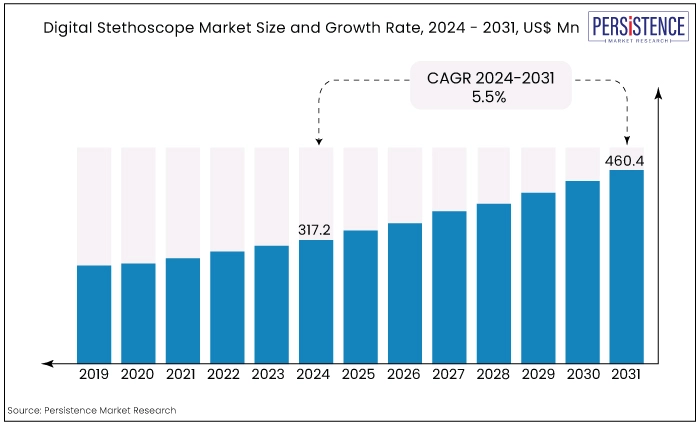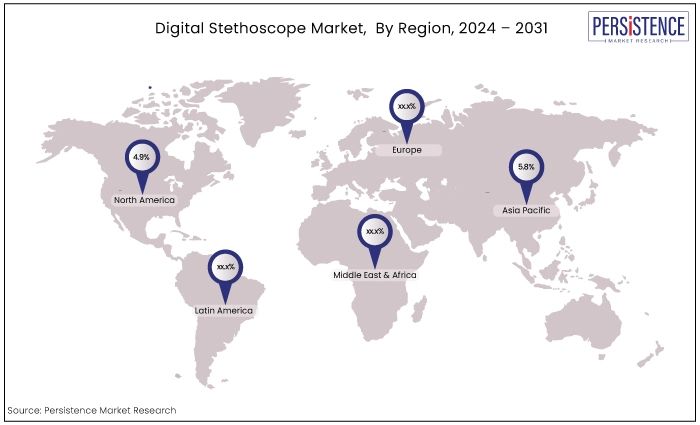Industry: Healthcare
Published Date: July-2024
Format: PPT*, PDF, EXCEL
Delivery Timelines: Contact Sales
Number of Pages: 153
Report ID: PMRREP34699
The global digital stethoscope market is estimated to value at US$460.4 Mn by the end of 2031 from US$317.2 Mn anticipated in 2024. The market is expected to secure a CAGR of 5.5% from 2024 to 2031.
Key Highlights of the Market
|
Market Attributes |
Key Insights |
|
Market Size (2024E) |
US$317.2 Mn |
|
Projected Market Value (2031F) |
US$460.4 Mn |
|
Forecast Growth Rate (CAGR 2024 to 2031) |
5.5% |
|
Historical Growth Rate (CAGR 2018 to 2023) |
4.4% |
The digital stethoscope market is rapidly evolving, driven by advancements in technology and increasing demand for enhanced diagnostic tools. The global digital stethoscope is experiencing rapid growth driven by advancements in technology, increasing healthcare needs, and the push for improved diagnostic tools.
Digital stethoscopes offer enhanced sound quality, recording capabilities, and integration with digital health records, making them a valuable tool in modern medical practice.
These stethoscopes represent a significant leap forward from traditional models, offering features such as real-time sound amplification, noise reduction, and integration with telemedicine platforms.
Such innovations enable healthcare professionals to capture and analyse heart and lung sounds with greater accuracy and clarity, facilitating more precise diagnoses.
The market is characterized by a growing adoption of digital stethoscopes across various healthcare settings, including hospitals, clinics, and remote monitoring environments.
This rise is fuelled by the increasing prevalence of chronic diseases, advancements in digital health technology, and a shift towards remote patient management.
The integration of artificial intelligence and machine learning further enhances the capabilities of digital stethoscopes, offering real-time diagnostic support and improving overall patient care.

The global digital stethoscope market has experienced robust growth from 2018 to 2023, which was primarily driven by several key factors, including the introduction of AI and machine learning in stethoscope technology enhanced diagnostic accuracy.
The COVID-19 pandemic significantly accelerated the adoption of telehealth services, necessitating advanced diagnostic tools like digital stethoscopes for remote patient monitoring. Increased awareness among healthcare professionals about the benefits of digital stethoscopes led to higher adoption rates.
Looking ahead, the digital stethoscope is poised for continued growth, driven by ongoing technological advancements, expanding telemedicine services, and increasing healthcare investments.
Growing healthcare infrastructure in emerging economies will create new opportunities for market expansion. continued growth in telemedicine will drive demand for digital stethoscopes that support remote diagnostics and patient monitoring.
Key regions driving market growth include North America, with its advanced healthcare infrastructure, and Asia Pacific, with its expanding healthcare investments and rising demand for innovative medical technologies.
As the healthcare landscape continues to evolve, digital stethoscope companies are well-positioned to capitalize on these trends, offering solutions that meet the needs of modern healthcare professionals and patients alike.
Increasing Prevalence of Chronic Diseases
The growing prevalence of chronic diseases is expected to be a major driver of this demand. As cases of heart disorders, lung diseases, and diabetes continue to rise, there is an increasing need for advanced diagnostic tools and early detection methods to manage and address these health conditions effectively.
For example, the Centers for Disease Control and Prevention (CDC) reports that around 129 million people in the United States are impacted by major chronic diseases such as heart disease, cancer, diabetes, obesity, and hypertension. This increase in chronic conditions is anticipated to drive market growth throughout the forecast period.
Embracing Digital Stethoscopes in Healthcare
While traditional stethoscopes have long been trusted by many medical professionals, there remains some hesitation to adopt digital versions. This reluctance is partly due to a strong attachment to the familiar analog devices that have proven reliable for generations of healthcare practitioners.
Additionally, the perceived complexity and learning curve associated with digital stethoscopes contribute to this hesitance. Some healthcare professionals worry that the transition might disrupt their workflow or require significant time to master the new technology.
Moreover, hospitals and healthcare facilities often view the adoption of digital stethoscopes as a time-intensive endeavor. Implementing these advanced tools necessitates not only purchasing the devices but also investing in training programs for staff.
The process can be seen as a burden, especially in busy medical environments where time is a precious resource. The initial investment in time and effort required for training can deter institutions from making the switch, despite the long-term benefits digital stethoscopes can offer.
Integration with Telemedicine and Remote Monitoring
The rapid expansion of telemedicine presents a significant opportunity for digital stethoscope companies. Digital stethoscopes can transmit high-quality audio of heart and lung sounds remotely, making them indispensable for virtual consultations.
As telehealth continues to grow, the demand for reliable, high-performance digital stethoscopes will increase, allowing companies to develop products specifically designed for telemedicine applications.
|
Category |
Projected CAGR through 2031 |
|
Product Type - Amplifying Stethoscope |
5.3% |
|
End-user - Hospitals |
5.1% |
Amplifying Stethoscope Continue to be the Bestseller Category Among Products
In 2023, the Amplifying Stethoscope segment is expected to hold the largest share of the global spine surgery robot’s market. In modern healthcare, medical professionals are placing greater emphasis on detecting early signs of health issues by meticulously monitoring heartbeats and sounds.
Amplifying digital stethoscopes are at the forefront of this shift, offering significant advantages over traditional stethoscopes. These advanced devices are designed to detect subtle signs that conventional stethoscopes might miss, making them invaluable tools for early diagnosis and intervention.
Traditional stethoscopes, while reliable, have limitations in amplifying faint sounds, which can be crucial for identifying early symptoms of cardiac and respiratory conditions.
Amplifying digital stethoscopes overcome these limitations by enhancing sound quality and clarity. This capability allows healthcare providers to discern even the most subtle abnormalities in heart and lung sounds, facilitating timely and accurate diagnoses.
Digital Stethoscopes Rise in Popularity as Hospitals Seek Seamless Integration
The spinal fusion accounted highest market share in 2023. Modern hospitals are increasingly adopting digital advancements, with private institutions leading the way in rapid modernization.
As a result, the use of digital stethoscopes is becoming more common in hospitals. However, smaller diagnostic and treatment centers often lack the financial resources and trained staff needed to effectively utilize digital stethoscopes.
In contrast, hospitals generally have the necessary budgets and skilled medical professionals to implement these advanced tools. Private hospitals offer significant opportunities for digital stethoscope adoption due to their substantial financial resources.
|
Region |
CAGR through 2031 |
|
North America |
4.9% |
|
Asia Pacific |
5.8% |
North America Holds a Significant Share of the Digital Stethoscope Market
North America holds a significant share of the digital stethoscope, driven by various factors including advanced healthcare infrastructure, technological innovation, and high healthcare expenditure.
The region's strong market position can be attributed to the robust adoption of digital health technologies and the presence of key industry players.
One of the primary reasons for North America's dominance in the digital stethoscope market is its well-established healthcare infrastructure. The US, and Canada have a large number of hospitals, clinics, and healthcare facilities that are equipped with the latest medical technologies.
Such institutions are early adopters of innovative diagnostic tools, including digital stethoscopes, which are increasingly used to enhance patient care and improve diagnostic accuracy.
Technological innovation is another critical factor contributing to North America's significant market share. The region is home to numerous leading medical device companies and tech startups that are at the forefront of developing advanced digital stethoscopes.
These companies are continuously investing in research and development to introduce new features such as AI-powered diagnostics, machine learning algorithms, and enhanced sound amplification. This constant innovation drives market growth and ensures that North America remains a key player in the digital stethoscope industry.
Asia Pacific to Exhibit Notable CAGR in the Global Digital Stethoscope Market?
The Asia Pacific region is poised to exhibit a notable CAGR in the global market, driven by several key factors including rising healthcare investments, technological advancements, and increasing awareness about advanced diagnostic tools.
One of the primary drivers of growth in the Asia Pacific digital stethoscope market is the significant increase in healthcare investments. Governments, and private sectors in countries such as China, India, Japan, and South Korea are investing heavily in healthcare infrastructure to meet the demands of their growing populations.
This investment is facilitating the adoption of advanced medical technologies, including digital stethoscopes, in hospitals and clinics across the region. Increasing awareness and acceptance of advanced diagnostic tools among healthcare professionals in the region further contribute to market growth.
As medical practitioners in Asia Pacific become more familiar with the benefits of digital stethoscopes, such as improved diagnostic accuracy and the ability to monitor patients remotely, the demand for these devices is expected to rise significantly. Educational initiatives, and training programs are helping to accelerate this acceptance and adoption.

The competitive landscape for the digital stethoscope market is dynamic and rapidly evolving, driven by technological advancements and increasing demand for more accurate and efficient diagnostic tools.
Key players in the market include established medical device companies, tech firms, and startups, each contributing to innovations in design, functionality, and integration with digital health platforms. Here are some key elements shaping the competitive landscape.
Recent Industry Developments
|
Attributes |
Details |
|
Forecast Period |
2024 to 2031 |
|
Historical Data Available for |
2018 to 2023 |
|
Market Analysis |
US$ Million for Value |
|
Key Regions Covered |
|
|
Key Market Segments Covered |
|
|
Key Companies Profiled in the Report |
|
|
Report Coverage |
|
|
Customization & Pricing |
Available upon request |
By Product Type
By Technology
By End User
By Region
To know more about delivery timeline for this report Contact Sales

The increasing demand for digital stethoscopes globally is driven by several key factors such as technological advancements, growing prevalence of cardiovascular and respiratory diseases, and integration with digital health records.
Some of the key players operating in the market are FarmaSino Pharmaceuticals, Contec Medical Systems, Hefny Pharma Group, Eko Health Inc., and 3M.
The market for digital stethoscope was valued at US$ 299.3 Mn in 2023.
The amplifying stethoscope segment is anticipated to hold the largest share of the global digital stethoscope market from 2024 to 2031 in terms of components.
The US holds the largest share in the global digital stethoscope market.